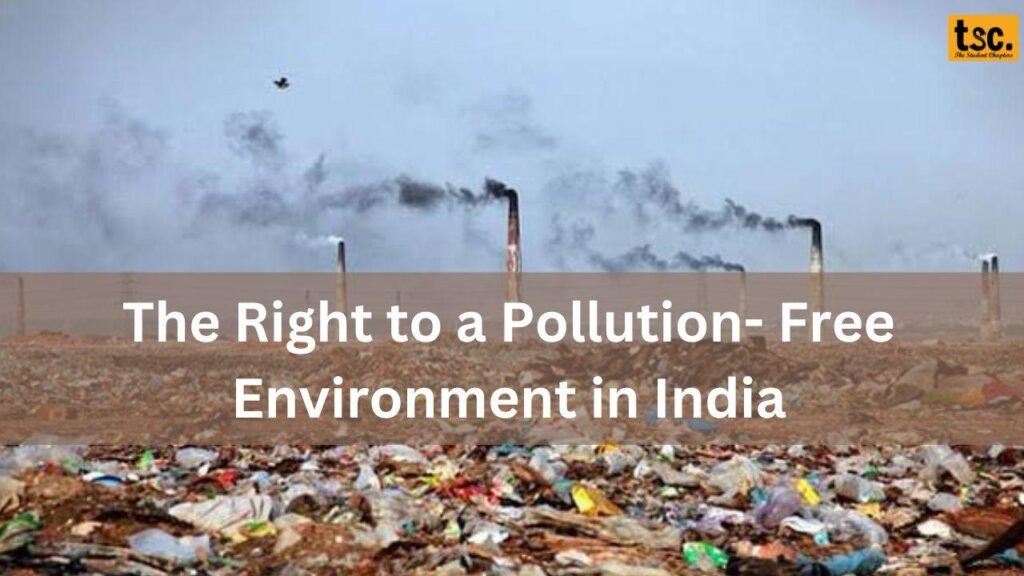The Right to a Pollution-Free Environment in India

The Right to a Pollution-Free Environment in India is a fundamental right. In India, the right to a pollution-free environment is not explicitly listed as a fundamental right in the Constitution. However, it has been recognized as part of the right to life under Article 21 of the Indian Constitution. This guarantees the “right to life and personal liberty” to every citizen. This interpretation has been shaped through judicial decisions, particularly by the Supreme Court of India and High Courts. These courts have expanded the scope of this right to include a healthy environment.
1. The Right to Life (Article 21)
The landmark case of Subhas Kumar v. State of Bihar (1991) is often cited as the foundation for this interpretation. In this case, the Supreme Court ruled that the right to life under Article 21 includes the right to live in a healthy environment, and that pollution is detrimental to this fundamental right. The court reasoned that access to a healthy environment is essential for fully realizing the right to life, and pollution directly impacts this right.
2. Environmental Jurisprudence and Judicial Activism
The Indian judiciary has been proactive in expanding the scope of environmental protection, considering a pollution-free environment as integral to the right to life. The Public Interest Litigation (PIL) system has been an important tool for citizens and environmental groups to address issues related to pollution and the environment. The Supreme Court and High Courts have passed several judgments that emphasize the state’s responsibility to protect the environment for the well-being of its citizens.
Notable cases include:
– Vellore Citizens Welfare Forum v. Union of India (1996): The Supreme Court ruled that industrial pollution is a violation of the right to life and health. The Court emphasized the “precautionary principle” and “polluter pays principle” in environmental matters.
– M.C. Mehta v. Union of India(1987): A series of cases involving industrial pollution, including the protection of the Taj Mahal from air pollution. The Court ruled that the government must take steps to ensure that environmental degradation does not infringe on citizens’ fundamental rights.
3. Fundamental Right vs. Directive Principles
Although the Constitution does not explicitly mention the right to a healthy environment as a fundamental right. The Indian Constitution encourages the broader concept of sustainable development under the Directive Principles of State Policy (Part IV of the Constitution), and it closely links to this concept. For example, Article 48A instructs the State to “endeavor to protect and improve the environment and to safeguard the forests and wildlife of the country,”. Article 51A(g) enjoins every citizen to “protect and improve the natural environment, including forests, lakes, rivers, and wildlife, and to have compassion for living creatures.”
Thus, these constitutional provisions, judicial interpretations, and evolving public policy on environmental protection derive the right to a pollution-free environment.
4. International Influence
India’s recognition of a healthy environment as part of the right to life. It has also been influenced by international environmental laws and frameworks, such as the UDHR and Agenda 21(1992). These calls for ensuring that human beings can live in an environment of quality.
5. Legislative Measures
While judicial interpretations have played a significant role. India has also enacted several laws to address environmental pollution and safeguard the right to a pollution-free environment. These include:
– The Air (Prevention and Control of Pollution) Act, 1981
– The Water (Prevention and Control of Pollution) Act, 1974
– The Environment Protection Act, 1986
– The National Green Tribunal (NGT) Act, 2010, which established a specialized tribunal for environmental protection and dispute resolution.
Thus, these legislative measures support the judicial interpretation that pollution is a violation of the right to a healthy and dignified life.
Conclusion
While pollution-free environment is not an explicit fundamental right under the Indian Constitution. Courts have interpreted it as an integral part of the right to life under Article 21. Moreover, the Indian judiciary has increasingly emphasized that the State must ensure a clean and healthy environment as part of its duty to protect the fundamental rights of its citizens. This evolving legal framework makes the right to a pollution-free environment a quasi-fundamental right in India, albeit one that is subject to practical and regulatory challenges. Thus, the Right to a Pollution-Free Environment in India is also a human and basic right.
Stay tuned on our website as if any official information pops up then we will update you in minutes! If you want all the latest updates on time then join our student community on WhatsApp!
Choose the right career for you by booking personal guidance from professionals on Mytagapp.com!









